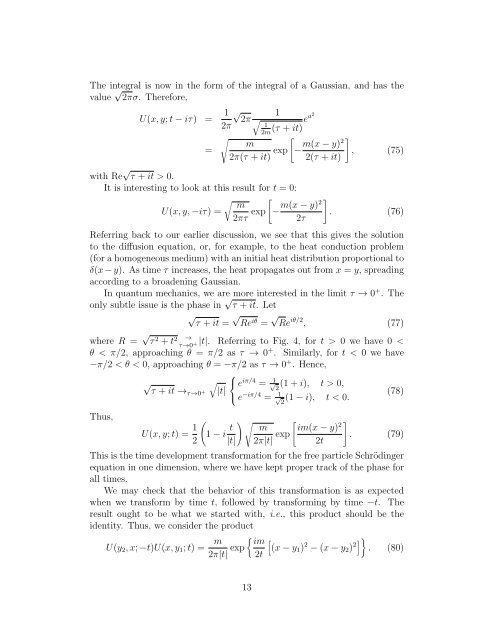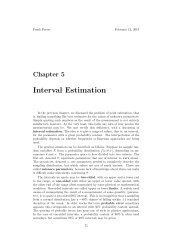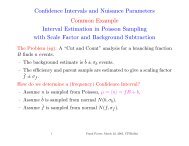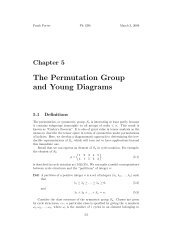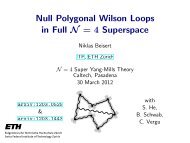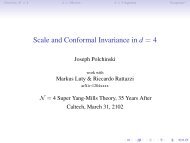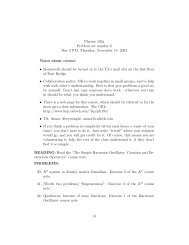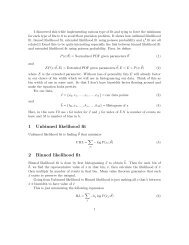1 Introduction 2 Resolvents and Green's Functions
1 Introduction 2 Resolvents and Green's Functions
1 Introduction 2 Resolvents and Green's Functions
You also want an ePaper? Increase the reach of your titles
YUMPU automatically turns print PDFs into web optimized ePapers that Google loves.
The integral is now in the form of the integral of a Gaussian, <strong>and</strong> has the<br />
value √ 2πσ. Therefore,<br />
U(x, y; t − iτ) = 1 √ 1 2π √<br />
2π<br />
1<br />
(τ + it)ea2<br />
2m<br />
√<br />
[<br />
]<br />
m<br />
=<br />
2π(τ + it) exp m(x − y)2<br />
− , (75)<br />
2(τ + it)<br />
with Re √ τ + it > 0.<br />
It is interesting to look at this result for t = 0:<br />
√ [<br />
]<br />
m<br />
U(x, y, −iτ) =<br />
2πτ exp m(x − y)2<br />
− . (76)<br />
2τ<br />
Referring back to our earlier discussion, we see that this gives the solution<br />
to the diffusion equation, or, for example, to the heat conduction problem<br />
(for a homogeneous medium) with an initial heat distribution proportional to<br />
δ(x − y). As time τ increases, the heat propagates out from x = y, spreading<br />
according to a broadening Gaussian.<br />
In quantum mechanics, we are more interested in the limit τ → 0 + . The<br />
only subtle issue is the phase in √ τ + it. Let<br />
√<br />
τ + it =<br />
√<br />
Re<br />
iθ<br />
= √ Re iθ/2 , (77)<br />
→<br />
where R = √ τ 2 + t 2 |t|. Referring to Fig. 4, for t > 0 we have 0 <<br />
τ→0 +<br />
θ < π/2, approaching θ = π/2 as τ → 0 + . Similarly, for t < 0 we have<br />
−π/2 < θ < 0, approaching θ = −π/2 as τ → 0 + . Hence,<br />
⎧<br />
√ √ ⎨ e iπ/4 = √ 1<br />
τ + it →τ→0 + |t|<br />
2<br />
(1 + i), t > 0,<br />
⎩ e −iπ/4 = √ 1<br />
(78)<br />
2<br />
(1 − i), t < 0.<br />
Thus,<br />
U(x, y; t) = 1 2<br />
(<br />
1 − i t ) √ [ ]<br />
m im(x − y)<br />
2<br />
|t| 2π|t| exp . (79)<br />
2t<br />
This is the time development transformation for the free particle Schrödinger<br />
equation in one dimension, where we have kept proper track of the phase for<br />
all times.<br />
We may check that the behavior of this transformation is as expected<br />
when we transform by time t, followed by transforming by time −t. The<br />
result ought to be what we started with, i.e., this product should be the<br />
identity. Thus, we consider the product<br />
U(y 2 , x; −t)U(x, y 1 ; t) =<br />
m<br />
2π|t| exp { im<br />
2t<br />
[<br />
(x − y1 ) 2 − (x − y 2 ) 2]} . (80)<br />
13


